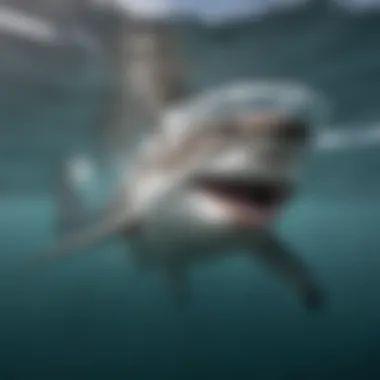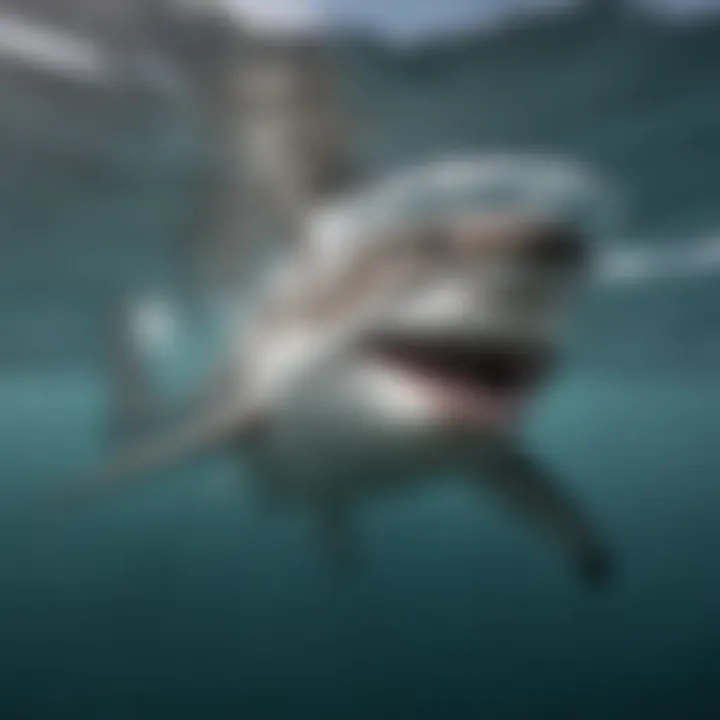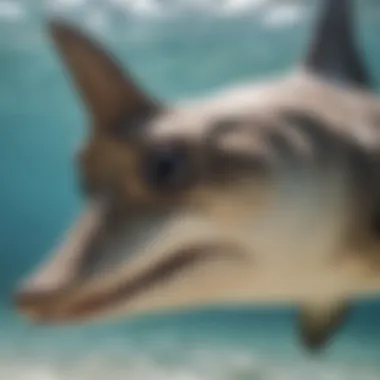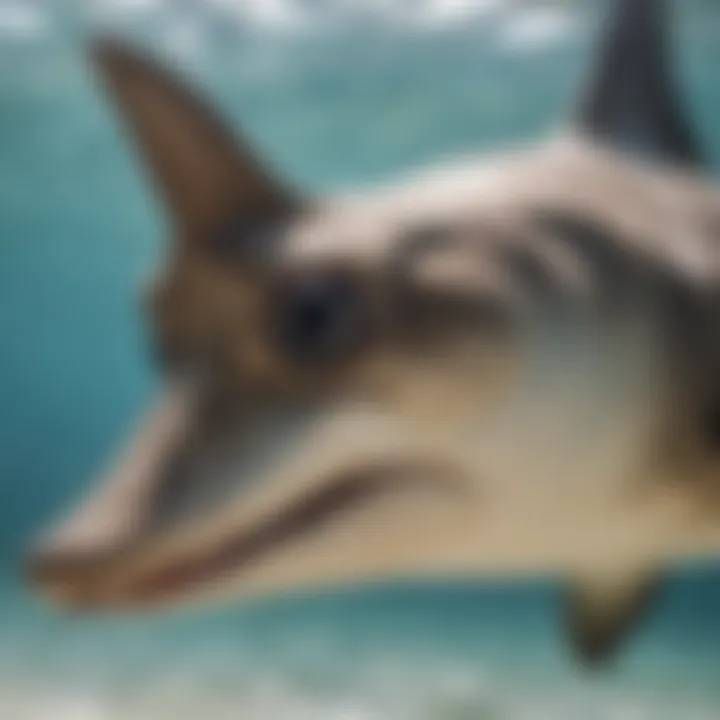10 Fascinating Facts About Sharks You Should Know


Intro
Sharks, the apex predators of the ocean, have captivated human imagination for centuries. Often mischaracterized as ruthless killers, these ancient creatures play a pivotal role in maintaining the balance of marine ecosystems. Understanding them is crucial—not just for marine conservationists, but for anyone who enjoys the ocean. In this article, we will explore ten insightful facts about sharks, providing a well-rounded view of their biology, behavior, and ecological importance.
As we dive into the watery world of these formidable creatures, it's important to set the stage. Sharks have existed for over 400 million years, far longer than dinosaurs, showcasing their resilience and adaptability. Despite their long-standing presence, many people have misconceptions about them, often influenced by media portrayals.
This exploration is not merely academic; by shedding light on the truth behind sharks, we aim to foster a greater respect for these magnificent animals and the delicate marine environments they inhabit. The following sections will illuminate aspects from their unique biological adaptations to their essential roles in ocean health.
Collectively, these facts will not only inform but also inspire a deeper appreciation for sharks, encouraging conservation efforts to protect these vital species. Let’s dive deeper and begin unpacking the first of many intriguing insights into the life of sharks.
Key Points to Consider
- Ancient Creatures: Sharks have a long evolutionary history stretching back millions of years, providing insights into their perseverance.
- Misconceptions: Often portrayed negatively, sharks are essential for healthy ecosystems, helping maintain fish populations and the overall balance.
- Ecological Impact: The decline of shark populations can lead to imbalances, adversely affecting various marine life forms.
- Diversity: Sharks are not a monolith; over 500 species exist, each with its own unique adaptations and behaviors.
Through this understanding, we hope not just to share knowledge, but to stimulate respect and curiosity towards sharks and the oceans they inhabit.
Understanding Shark Anatomy
The anatomy of sharks is a fascinating and intricate design, built over millions of years of evolution to equip them as formidable predators in the ocean. Understanding the specific structures and adaptations sharks possess is crucial, as this knowledge lays the foundation for appreciating their role in marine ecosystems. Sharks' anatomy showcases a range of characteristics that distinctly differentiate them from other marine life forms, particularly bony fish. By grasping the essential components like their skeletal structure and sensory adaptations, we can better acknowledge their ecological importance.
Skeletal Structure
Cartilaginous framework
Sharks boast a cartilaginous framework rather than the bony structure found in most fish. This unique trait enables them to enjoy a lighter and more flexible body, which is particularly advantageous for swift movements through the water. The key characteristic of a cartilaginous skeleton is its composition; being made of cartilage instead of bones allows sharks to be both agile and buoyant.
This flexibility is essential for their hunting strategies, letting them maneuver quickly and strike with precision. The beneficial aspect of this framework is its ability to absorb shocks, reducing the risk of fracture during high-speed pursuits. While this skeletal choice comes with the disadvantage of providing less support compared to bones, it significantly enhances their overall swimming efficiency, making sharks extraordinary hunters.
Differences from bony fish
The differences between sharks and bony fish go beyond just the type of skeleton. Bony fish possess a rigid bony structure that provides both support and protection, whereas sharks rely on their cartilaginous construction for agility. This distinction is a crucial element in understanding how each group of fish adapts to their environment.
Bony fish often have swim bladders to maintain buoyancy, while sharks utilize their large oily liver to help keep them afloat. This results in a unique adaptation, with sharks needing to continuously swim to maintain their position in the water column. As such, these differences highlight the advantage of sharks being able to rapidly respond to their surroundings without the heavy framework that bony fish must manage. These adaptions pinpoint sharks' evolutionary success and their capability to thrive in various marine environments, making them captivating subjects of study.
Sensory Adaptations
Electroreception
Electroreception is another standout feature in sharks, enabling them to detect electrical fields generated by the movements of other animals. This ability enhances their hunting effectiveness, especially in murky waters where visibility is limited. The presence of ampullae of Lorenzini, specialized electroreceptors, exemplifies how sharks can sense weak electric fields. This key characteristic is nothing short of a game-changer for a predator navigating their ocean realm.
The beneficial aspect of electroreception is evident as it allows sharks to locate prey even when they are hidden beneath sand or camouflaged in plants. Still, the application of this sense also reveals a disadvantage— sharks may be sensitive to overly powerful electrical fields, which can confuse their navigation systems. However, the overall advantage provided by this sensory adaptation far outweighs any potential drawbacks, solidifying its place in the formidable toolkit of shark anatomy.
Enhanced smell
Sharks are renowned for their acute sense of smell, which can detect blood and other scents from potentially miles away. The ability to pick up on small concentrations of chemicals in the water is nothing short of astounding. This key characteristic of enhanced olfactory senses works like a finely tuned radar, directing sharks to food sources effectively.
One fascinating feature of this adaptation is that sharks have more olfactory receptors than most fish, with estimates suggesting they might discern scents in concentrations as low as one part per million. This aspect sheds light on why they are often at the top of the food chain; their ability to detect prey from great distances allows them to conserve energy while hunting. The disadvantage, however, can be that they might also be lured toward unnatural scents, possibly leading to dangerous encounters with humans. Nonetheless, enhanced smelling not only highlights their mastery as predators but also emphasizes their ecological significance, anchoring their role in the marine food web.
"Understanding sharks' anatomy opens up a world of insight that showcases their incredible adaptations and evolutionary finesse. Much more than just fearsome hunters, they play an invaluable role in our oceans."
In summary, comprehending the anatomy of sharks illuminates the mechanics behind their survival, acting as a cornerstone in realizing why they are so crucial to marine ecosystems.
Diversity of Species
The diversity of shark species is an essential aspect of understanding these incredible creatures. The sheer variety provides insights not only into their evolutionary history but also into their ecological roles within marine ecosystems. Sharks are not just uniform hunters; they represent a vast array of adaptations that allow them to thrive in various environments. Recognizing this diversity helps us appreciate the significance sharks hold in the ecosystem, as well as the challenges they face due to human activities.
Number of Species
Estimate of species
The estimate of shark species has grown significantly over the years. Recent studies suggest there are about 500 identified species, but this number could be higher as researchers continue to discover new varieties in the deep blue or even in coastal waters. This increase in knowledge showcases how the field of marine biology is evolving, much like any other area of science.
One notable characteristic of these estimations is that they highlight the mystery surrounding many species. Many sharks remain elusive, lurking in the depths where few humans venture. The discovery of new species contributes to our overall understanding of marine life and what the oceans harbor. It also emphasizes the crucial need for further exploration and conservation initiatives.
The unique feature of estimating shark species is the variation in adaptations each species exhibits. Some are built for speed, while others are masters of camouflage. This diversity allows a variety of niches to be filled, fostering balance in the oceanic ecosystem. However, the downside is that habitat loss and overfishing threaten many of these species, making every point about diversity significantly relevant in discussions about conservation.
Regional variations
Regional variations of shark species illustrate how their forms are shaped by local environmental conditions. In coastal areas, it is common to find species such as the great white shark and the tiger shark, while deep-sea varieties, such as the goblin shark, are rare and seen very infrequently. This geographical disparity reveals how sharks adapt to their surroundings, developing unique traits suited to local conditions.
One of the notable aspects is the wide range of habitats sharks occupy worldwide. From tropical coral reefs to icy Arctic waters, these creatures adapt remarkably well. These adaptations can make them more effective hunters or provide better protection against other predators.
However, with varying habitats comes greater vulnerability. For instance, coastal sharks often face threats from pollution and fishing, while deep-sea sharks might be impacted by deep-sea mining or changes in ocean temperatures. Understanding these regional variations not only aids in conservation planning but also gives insight into how environmental changes can impact species diversity.
Habitat Preferences
Coastal versus deep-sea sharks
Shark species display distinct habitat preferences that can drastically affect their lifestyles and survival. Coastal sharks, like hammerheads, thrive in warmer waters, often in proximity to shorelines, and are visible to the human eye during fishing expeditions. Deep-sea sharks, on the other hand, remain less seen and less understood, dwelling in depths that can exceed hundreds of meters.
The key characteristic separating these two categories is their adaptability. Coastal sharks often adapt to changing environments, using shallow waters for hunting, while deep-sea sharks have evolved to navigate the dark depths, relying on bioluminescent hunting techniques.
While coastal sharks enjoy abundant prey, their populations are heavily impacted by human activities, like fishing and habitat destruction. Deep-sea sharks may be more insulated from these pressures, but they face challenges as oceanic changes occur. In summary, each habitat poses unique benefits for these species, yet both face environmental pressures that can affect their sustainability.
Environmental adaptability
Environmental adaptability is a crucial concept when discussing sharks. The way these species respond to changes in their habitat directly affects their survival. Some species, like the bull shark, can thrive in both saltwater and freshwater, showcasing their versatility.
This adaptability allows sharks to inhabit a broad spectrum of environments, from river mouths to offshore waters. It’s a beneficial trait in today’s changing climate, making many species resilient to seasonal shifts or fluctuations in prey availability.


Yet, there are disadvantages. Sharks with specialized habitats can suffer greatly from environmental changes; for instance, those reliant on coral reefs are at risk as reefs decline due to bleaching. Understanding these adaptive capabilities emphasizes the importance of protecting diverse marine environments, which ultimately supports the survival of various shark species.
"Understanding these various adaptations is crucial to safeguarding not just sharks, but the marine ecosystems they support."
Reproductive Strategies
Understanding how sharks reproduce is crucial for appreciating their biology and the roles they play in the marine ecosystem. Unlike many fish, sharks have various reproductive strategies that contribute to their survival and adaptability. These strategies not only ensure the continuation of species but also reflect the evolutionary paths they have taken in response to environmental pressures. In this section, we’ll examine the two primary types of reproduction in sharks, as well as their methods of parental care and how these factors affect shark populations.
Types of Reproduction
Oviparous versus viviparous
Sharks exhibit two main reproductive methods: oviparous and viviparous.
In oviparous sharks, which lay eggs, the young develop outside the mother's body. A notable example of this would be the dogfish shark, which lays eggs encased in a protective capsule. The unique feature of this method is how it allows the eggs to be hidden in crevices or on the ocean floor, which can deter predators. This strategy offers a certain level of security to the developing embryos, though it can also limit the number of offspring since each egg must be produced independently.
In contrast, viviparous sharks, such as the hammerhead, carry their young internally until they’re ready to be born. This method can increase survival chances, as developing pups are safer within the mother’s body. The risk here, however, is that the mother only has limited capacity to carry a handful of pups at once, which might affect population levels in hunted species.
Both types of reproduction are noteworthy in understanding how sharks adapt to their environments and resources, promoting both species diversity and survival.
Gestation periods
Gestation periods in sharks can vary widely, from just a few months to over a year, depending on the species. For example, the great white shark has one of the longest gestation periods, lasting up to eleven months. This prolonged development allows the pups to grow larger before birth, thus improving their chances of survival in the tough ocean environment.
The variation in gestation is significant as it indicates how different species have evolved to tackle various survival challenges. Longer gestation periods generally mean more developed fry at birth, which means that pups have better chances for survival compared to those born earlier but smaller.
The unique aspect of gestation is that it reflects the mother’s investment in the pups. Longer gestation can be beneficial in terms of initial survival rates, whereas quicker gestation may spread out reproductive efforts but could result in higher risk during early life stages.
Parental Care
Role of maternal care
Maternal care in sharks is another fascinating aspect of their reproductive strategy. While it varies among species, some mothers exhibit protective behaviors toward their pups post-birth. For instance, the nurse shark stays with the young for a period after they are born, offering them some degree of protection from predators. This bond can be pivotal in increasing survival rates for young sharks.
By nurturing their young—either through protection or aid in initial feeding—mothers enhance the chances of their offspring growing to adulthood. This strategy highlights a deeper parental investment, emphasizing the importance of maternal roles in enhancing pup survival.
Survival rates of pups
Survival rates of shark pups can significantly differ based on their mother’s care and the environment they are born into. It is estimated that many species, such as the lemon shark, have survival rates that can be as low as five percent when pups are born without maternal support.
Factors such as predation, habitat availability, and food resources heavily influence these rates. In species where mothers provide care or stay close to their young, survival rates often surge, showcasing that maternal protection can be a game-changer for newborn sharks. The uniqueness of this care constitutes a crucial element in their reproductive strategy, demonstrating how vital these early life stages are to population sustainability.
"Sharks' reproductive strategies are as diverse as they are fascinating, highlighting their adaptability in the face of changing marine environments."
With this nuanced understanding of how sharks reproduce, we can appreciate the challenges they face and recognize the crucial role they play in the balance of marine ecosystems.
Behavioral Traits
Understanding shark behavior is crucial for grasping how these ancient creatures interact within their environments. Behavioral traits give insights into their survival strategies, social dynamics, and role in marine ecosystems. For those involved in water sports like surfing or paddleboarding, acknowledging these traits can shape safer practices and a renewed respect for these predators. It can lead to a more harmonious interaction between humans and these extraordinary creatures.
Hunting Techniques
Group hunting behavior
Group hunting is a fascinating social trait seen in various shark species. This strategy allows sharks to coordinate their movements, maximising their chances of a successful catch. For instance, blacktip reef sharks are known to hunt in groups, creating a dynamic where they can corner prey, such as schools of small fish.
- Key Characteristic: One key feature of this behavior is the coordination of attacks, which is often subtle but highly effective. They work together, almost like a choreographed dance, driving their prey into tighter spaces.
- Benefits: This group tactic not only increases the probability of catching food but also allows for shared energy expenditure. By working as a team, sharks can hunt without exhausting themselves.
- Unique Feature: A unique aspect of group hunting is the formation of circles around their prey. This encirclement keeps the target contained, making it easier to launch a successful strike.
Ambush tactics
Ambush tactics represent a highly efficient method of predation, where sharks position themselves strategically and wait for unsuspecting prey to swim by. Species like the great white shark excel in this form of hunting, utilizing their surroundings for cover.
- Key Characteristic: The stealth approach is integral to this tactic. It relies on patience, allowing sharks to conserve energy while silently waiting to strike.
- Benefits: This method can yield high rewards with minimal energy loss. Sharks who master this technique can afford to be selective about their prey, targeting larger fish or seals that provide more sustenance.
- Unique Feature: Another compelling aspect is the dramatic speed at which they launch themselves. Once the prey is close enough, sharks utilize their powerful muscles to dart out, often catching their unsuspecting targets off-guard.
Social Structures
Solitary versus social species
In the ocean, there’s a mix between solitary and social species, and understanding these differences can greatly enhance our insight into shark ecology. Hammerhead sharks are an example of a more social variety, traveling in schools while other species like the tiger shark often prefer solitude.
- Key Characteristic: Social species might exhibit complex group dynamics, whereas solitary ones tend to focus on individual hunting. This distinction can affect their feeding efficiency and adaptability to habitats.
- Benefits: Social species often find safety in numbers, which can provide protection against larger predators and enhance hunting efficiency.
- Unique Feature: The social structures can also reveal insights into their reproductive habits, as social sharks may display different mating rituals compared to solitary ones.
Communication methods
Another compelling aspect of shark behavior is communication, which is crucial for survival and social interaction. Sharks communicate primarily through body language, movements, and even some forms of sound.
- Key Characteristic: Their communication is often subtle, relying on posture changes and swimming patterns to signal intention or presence to other sharks.
- Benefits: Understanding these signals can provide critical information for researchers and ocean enthusiasts alike, as it can reveal how sharks interact within schools, during mating, or when confronting threats.
- Unique Feature: In some cases, the unique ability to pick up on vibrations through the water can allow sharks to “converse” silently, increasing their stealth in both hunting and social situations.
Sharks in the Ecosystem
Sharks are often viewed as the titans of the ocean, commanding respect due to their critical roles in marine ecosystems. Understanding their position helps illuminate the delicate balance of the oceanic food web, where sharks act as apex predators. They exert a top-down control on prey populations, influencing the health and diversity of species beneath them. This ecosystem role is vital; without sharks, certain prey species may proliferate unchecked, leading to overgrazing or depletion of vital resources.
The ecological significance of sharks cannot be overstated, and their conservation is paramount for the well-being of entire marine habitats. It’s not just about keeping the oceans filled with sharks but ensuring that the health of the marine environment is preserved for future generations.
Role as Apex Predators
Impact on Prey Populations
Sharks wade into the role of apex predators by maintaining the balance of prey populations. They take out the old and sick, which is crucial for the health of species like fish and crustaceans. This keeps the populations from exploding and provides opportunities for healthier individuals to thrive.
An interesting characteristic of this impact is how it cascades through the ecosystem. When sharks reduce certain species, it allows other marine animals to flourish. Imagine a scenario where the shark populations dwindle—there's a good chance that smaller fish will multiply and overconsume the algae that marine seagrasses need to survive. It becomes a domino effect, altering the entire marine landscape drastically. This link between sharks and their prey illustrates not only the uniqueness of their role but also why sharks are seen as a beneficial symbol for marine preservation.


Balance within Marine Ecosystems
When it comes to balance within marine ecosystems, sharks do an admirable job of keeping various species in check. By keeping prey populations stable, they ensure that no single species dominates, maintaining biodiversity in the underwater world. Sharks influence predator-prey dynamics, which is essential for the overall health of marine life. This dynamic can directly impact the availability of food sources, affecting fishermen and coastal communities that rely on diverse marine species.
A unique feature of this balance is that it fosters resilience in marine environments. Healthy shark populations mean healthier oceans. When sharks are present, ecosystems may adapt better to environmental changes and disturbances, such as storms or pollution. For readers, especially those engaged in marine activities like surfing or kitesurfing, this information underscores the importance of preserving the natural order of the seas.
Conservation Status
Threats Facing Shark Populations
Shark populations face numerous threats, making their conservation a pressing issue. Overfishing, driven by the demand for shark fins and meat, tops the list. This relentless pursuit isn’t just about catching sharks; it’s about an entire industry relying on the species being targeted. Fishermen often catch sharks unintentionally, leading to high mortality rates in juvenile and breeding populations.
A key characteristic of these threats is how they come from both legal and illegal fishing practices. Notably, the methods used often lead to wasteful bycatch, where other marine species also suffer. This dilemma highlights why understanding the fishing practices impacting sharks is a critical choice for advocates of marine conservation.
Efforts in Conservation
Despite the grim situation, various conservation efforts are underway to protect shark species. Organizations are pushing for stronger regulations and creating marine protected areas where sharks can thrive without interference from commercial fishing or habitat destruction. This includes treaties like the Convention on International Trade in Endangered Species (CITES), which is pivotal in managing shark populations on a global scale.
The advantage is that many of these efforts foster community engagement, inviting local populations to participate in conservation initiatives. This collaboration provides economic incentives for communities to engage in sustainable practices rather than exploiting marine resources. By addressing the connection between conservation and local livelihoods, these initiatives are becoming increasingly effective.
"Sharks are not just the rulers of the deep; they are the heartbeat of our oceans".
Misconceptions about Sharks
Understanding the misconceptions surrounding sharks is crucial for anyone engaging with these remarkable creatures. Misunderstandings often stem from a blend of folklore, cinema, and sensational media coverage, contributing to an unfounded fear that overshadows the truth about sharks. This section aims to dispel common myths, highlighting the realities of shark behavior and their role within marine ecosystems.
Shark Attacks
Statistics on shark attacks
When discussing shark attacks, the statistics serve as a vital tool to shed light on reality versus fear-driven narratives. It’s often reported that the likelihood of suffering a shark attack is exceedingly small.
In fact, according to the International Shark Attack File, the odds of getting attacked by a shark are about 1 in 11.5 million. This figure emphasizes that significant focus on shark attacks tends to overshadow their ecological importance and the much higher risks present in daily human activities.
Some unique features of these statistics include:
- The geographical hotspots where most attacks occur, primarily near popular beach areas.
- The data collection methods that have improved over time, allowing for more accurate tracking of incidents.
Ultimately, these facts serve to inform rather than incite fear, showing why understanding statistics related to shark attacks can foster a more balanced perspective on ocean conservation.
Factors contributing to attacks
Several contributing factors to shark attacks further debunk the myths surrounding these creatures. Understanding these factors can offer clarity and foster greater respect for sharks, showcasing much of the behavior as instinctual rather than malicious.
Key aspects include:
- Environmental conditions, such as murky waters where sharks may mistakenly identify humans as prey.
- Human activities, like fishing and swimming in biologically rich areas, which attract sharks due to bait or natural prey.
The unique element here is acknowledging that many attacks occur when sharks are merely investigating their environment, not necessarily attacking with intent. Providing a clearer perspective on these factors promotes a deterrent against fear, allowing for more informed discussions about safe practices in ocean activities for surfers, paddleboarders, and kitesurfers.
Sharks as Monsters
Cultural depictions
Sharks have long been depicted in popular culture as menacing creatures, reinforcing the idea that they are ruthless predators. Movements in film, such as the infamous Jaws, have amplified this image, often failing to represent sharks' true ecologies and behaviors.
Such cultural depictions are significant because:
- They shape public perception, leading to increased fear and misunderstanding.
- Educators and marine conservationists face the difficult task of changing these narratives.
Interestingly, while these portrayals can attract audiences, they often do a disservice to the reality of sharks and skew the true science of marine life.
Reality versus perception
Reality versus perception is an ongoing theme in the conversation about sharks. While popular media has created an air of fear surrounding them, the actual behavior of sharks is not as lethal as often portrayed.
For example, many sharks are actually quite timid and prefer to avoid human contact. The misconception that all sharks are dangerous overlooks the diversity among species, where the majority pose little to no threat.
Key characteristics addressing the reality include:
- Species diversity, understanding that not all sharks share the same traits or behaviors.
- Behavioral patterns, emphasizing that they primarily prey on fish and marine mammals, not humans.
Promoting a more informed perspective on the reality of sharks can help to develop respect for them as essential components of their ecosystems rather than the monsters they are often depicted to be.
"Sharks play a crucial role in maintaining the health of marine ecosystems, a reality that should be emphasized rather than the hyperbolic narratives of fear and aggression."
By changing narratives and addressing misconceptions, the oceans can be a more harmonious environment, encouraging those who appreciate water sports to foster a deeper connection with these incredible animals.
Sharks and Humans
Sharks have fascinated human beings for centuries, and this connection runs deeper than mere curiosity. Their role within the environment, how they interact with human activities, and what they represent in culture and economy are significant elements that shape our perception of these creatures. Understanding these relationships helps us appreciate their presence in our oceans and recognizes our responsibility towards their conservation.
Cultural Significance
Sharks in mythology
Across various cultures, sharks have been woven into the fabric of mythology, embodying characteristics that often transcend their biological nature. In Polynesian culture, for instance, sharks are revered as guardians of the sea, symbolizing strength and power. The stories often emphasize respect and reverence, reflecting a deep connection between humanity and these formidable creatures.
This aspect of mythologies serves a crucial purpose: it fosters a sense of respect for the oceans and their inhabitants, reminding us of our place within this intricate ecosystem. A key characteristic of these myths is their ability to convey moral lessons about the balance and harmony of nature. They often instill caution within local communities, highlighting the need for sustainable practices in fishing and tourism.


Moreover, the unique feature of incorporating sharks into mythology is their ability to aid in the preservation of local traditions. By celebrating these narratives, communities benefit culturally and encourage a collective effort towards conservation. However, it’s vital to approach these stories mindfully, ensuring they do not inadvertently incite fear but rather promote understanding.
Influence on art and literature
Sharks have left an indelible mark on art and literature, exhibiting their complex symbolism. From Jaws, the monumental novel by Peter Benchley, to striking works of visual art inspired by these sharks, they encapsulate fear, admiration, and intrigue. This duality represents humanity's conflicted feelings about these creatures; we are both captivated and anxious about their potential.
The key characteristic of sharks' influence in art lies in their stark representation of nature's raw power, often inviting viewers and readers to grapple with their own perceptions of danger versus wonder. They frequently appear as metaphors for instincts and primal fears, rendering sharks a beneficial tool in narratives that deal with morality or survival.
Additionally, this unique feature of shark-inspired art resonates powerfully with audiences, creating a ripple effect that can drive interest in marine conservation. Yet, there exists a disadvantage; often, these portrayals can reinforce negative stereotypes, leading to misunderstanding and stigma. It’s essential to navigate this dialogue carefully, acknowledging both sides of the coin.
Ecotourism and Conservation
Shark diving experiences
The boom in ecotourism has ushered in a new way for people to experience sharks firsthand through activities like shark diving. These experiences allow individuals to observe sharks in their natural habitats, transforming fear into fascination. Ecotourism can play a vital role in educating the public about the importance of sharks in our oceans and fostering an appreciation for their beauty and complexity.
What makes shark diving particularly appealing is its capacity to enhance awareness about marine conservation. Participants often leave with a genuine desire to advocate for the protection of these species. Unique features such as the opportunity to communicate with marine biologists onboard dive trips add substantial value. However, there is a caveat; improperly regulated shark diving can lead to disturbances in their natural behaviors and habitats.
Benefits of ecotourism
Ecotourism, specifically related to sharks, offers a myriad of benefits to local communities and the global environment. For one, it creates economic opportunities that prioritize conservation over exploitation, reducing the reliance on fishing and finning practices known to endanger shark populations. Additionally, ecotourism fosters a connection between communities and their marine environments, resulting in collective actions toward preserving natural resources.
The key characteristic of ecotourism is its ability to generate meaningful dialogue about conservation efforts. By engaging local populations and visitors alike, it brings attention to the urgent need for protecting these species. One unique feature is its capacity to improve local economies by bringing in tourists eager to learn about marine life, contributing to long-term sustainability. On the flip side, there is also a risk; if not managed properly, there’s potential harm to the very ecosystems that ecotourism aims to protect. Thus, careful planning and ongoing education are essential for maximizing the positive impacts of ecotourism on both sharks and the communities surrounding them.
"Shark diving experiences bridge fear and admiration, leading to a deeper understanding of these ancient creatures."
In summary, the interactions between sharks and humans, through culture, art, and ecotourism, highlight the complex relationship we share with these ocean dwellers. Recognizing their importance can translate into meaningful conservation efforts. With committed actions, we can help preserve not only the sharks themselves but also the rich tapestry of life that thrives beneath the waves.
Scientific Research on Sharks
Understanding sharks is essential for their conservation and management. Scientific research on sharks focuses on various aspects of these creatures, revealing insights into their biology, behavior, and interactions with ecosystems. This knowledge not only enhances our appreciation for sharks but also aids in developing policies that protect them. As apex predators, sharks play a vital role in maintaining the balance within marine ecosystems. Thus, effective research strategies can make a significant impact in preserving these ancient animals.
Innovative Research Techniques
Tagging and tracking
Tagging and tracking sharks have become valuable tools in marine science. By attaching tags equipped with monitoring devices to sharks, researchers can gather data on their movement patterns and behaviors. This method highlights the migratory routes sharks take, providing clues on their breeding grounds and feeding habits. One key characteristic of tagging is that it allows scientists to follow sharks over long distances without disturbing their natural environment.
However, though tagging can be effective, it is not without its challenges. For instance, casting tags can be difficult in remote areas where sharks might inhabit. Plus, the process itself may cause stress to the animal, which is a vital consideration in research ethics. Despite these issues, tagging remains a popular choice due to its relatively low cost and ability to generate substantial long-term data on shark populations.
Genetic studies
Genetic studies delve deeper into the evolutionary traits of sharks. By analyzing DNA, scientists can uncover information about genetic diversity, population structures, and even mating behaviors. This aspect is critical for understanding how different shark species adapt to their environments and cope with changes such as climate shifts or habitat degradation. Genetic research is beneficial because it offers a detailed look at how different populations of sharks interact and migrate, which can inform conservation strategies.
A unique feature of genetic studies is their ability to reveal hidden connections among populations. However, it requires advanced laboratory techniques and may not yield immediate results compared to tagging. While costly, the insights gained can greatly aid in preserving biodiversity and understanding the ecological roles of sharks.
Implications of Research
Understanding shark behavior
A significant aspect of scientific research on sharks is understanding their behavior. This branch of study helps clarify how sharks respond to environmental factors, prey availability, and human activities. By monitoring sharks, scientists can gather ample data that uncovers patterns in their hunting strategies and social interactions. Understanding shark behavior is beneficial as it aids in predicting how they might react to changes in their environment.
One advantage of studying behavior is that researchers can identify critical habitats necessary for breeding or feeding, guiding conservation efforts. Yet, this type of research can be complex due to the variation in individual shark behavior, influenced by factors such as species, age, and environmental conditions. Researchers must balance their efforts between general patterns and particular behaviors to yield meaningful insights.
Conservational strategies
Conservation strategies arise as an essential outcome of scientific studies on sharks. Through research, scientists can highlight the specific threats sharks face and propose actionable solutions. Establishing marine protected areas (MPAs) is one example of a strategy supported by research findings. These areas work to minimize human impact and create safe havens for sharks and their prey.
A vital characteristic of conservation strategies is that they are often multifaceted. Combining habitat protection, sustainable fishing practices, and public awareness creates a more robust approach. However, implementing these strategies can be resource-intensive and may require communities to alter their fishing habits or practices, leading to resistance from local fishermen.
Future of Sharks
Understanding the future of sharks is vital not just for the creatures themselves, but for the overall health of marine ecosystems. This section will shine light on two key components: environmental changes and policy efforts that are impacting shark populations globally. Each aspect offers unique insights into how challenges are shaping the lives of sharks and what can be done to ensure their survival.
Environmental Changes
Impact of climate change
One profound impact of climate change is the shifting habitats of sharks. As ocean temperatures rise, the water's chemistry alters, notably affecting the coral reefs that many sharks rely on for their sustenance. More acidic oceans can decline fish populations, which directly impacts the food chain, leading to fewer sharks in certain areas. The rising sea levels, melted ice caps, and storms also change the breeding grounds of many species. Understanding these changes is crucial, as sharks are indicators of ocean health. If their populations diminish, it suggests that the marine ecosystem is facing serious challenges. This makes the study of climate impacts particularly relevant.
Sharks’ ability to adapt to these changing conditions may also be varied across species, with some displaying more resilience than others. For instance, species like the bull shark can thrive in both freshwater and saltwater, giving them a leg up compared to more specialized sharks. However, the long-term consequences of such climate shifts could mean unpredictable changes in migration, population distribution, and breeding behavior.
Fishing pressures
Fishing pressures present another significant challenge for sharks. Overfishing and the practice of bycatch are drastically reducing many shark species. In particular, demand for shark fins has alarming consequences. As populations dwindle, the ecological imbalance grows, potentially leading to an increase in prey species that sharks normally control. This can have cascading effects on marine environments.
Moreover, the economic incentives behind shark fishing often overshadow conservation efforts. Sustainable practices are not yet widespread, making it tougher for many shark species to rebound from population declines. Addressing fishing pressures can offer a pathway to healthier oceans, promoting balance both ecologically and economically. By pushing for stricter regulations and responsible fishing methods, the tide can slowly shift — benefiting not just sharks themselves, but the health of the marine ecosystem.
Policy and Conservation Efforts
International treaties
International treaties play an important role in shark conservation efforts. Treaties such as the Convention on International Trade in Endangered Species aim to regulate the trade of endangered species, including various sharks. By placing stringent measures around the harvesting and trading of these sharks, there is at least some safeguard against further decline.
What distinguishes these treaties is their focus on collective action. Countries around the world need to come together to form a united front in addressing shark conservation. It’s also worth noting that treaties can create frameworks for funding and implementing research, education, and community involvement in conservation projects. While they are essential tools for change, their effectiveness often depends on the political will of the involved nations and their commitment to enforcing regulations.
Community-driven initiatives
Community-driven initiatives are significant in shaping the future of sharks as well. Local communities play a pivotal role in conservation efforts, particularly in regions where sharks are integral to cultural heritage and local economies. Initiatives such as shark sanctuaries, where fishing is prohibited, have seen communities take charge of protecting their marine resources.
These efforts often result in an increase in local tourism, particularly through ecotourism activities like shark diving, which not only helps local economies but also fosters a deeper respect for marine life. Community involvement encourages a sense of ownership over resources, leading to better outcomes for both sharks and local residents.
Ultimately, both policies and grassroots movements work hand in hand to create a sustainable future for sharks. Without concerted efforts from every level — from local communities to international bodies — the future can appear bleak. Yet, with awareness building and initiatives in place, there is hope for these majestic creatures and the ecosystems they inhabit.
"The future of sharks is intertwined with the health of our oceans. Protecting them means protecting our marine environments for generations to come."
In summary, there’s a compelling case for addressing the challenges posed by environmental shifts and human activities. By focusing on lasting policy changes and collaborative actions, we can navigate through the murky waters ahead, ensuring that sharks not only survive but thrive in our oceans.



